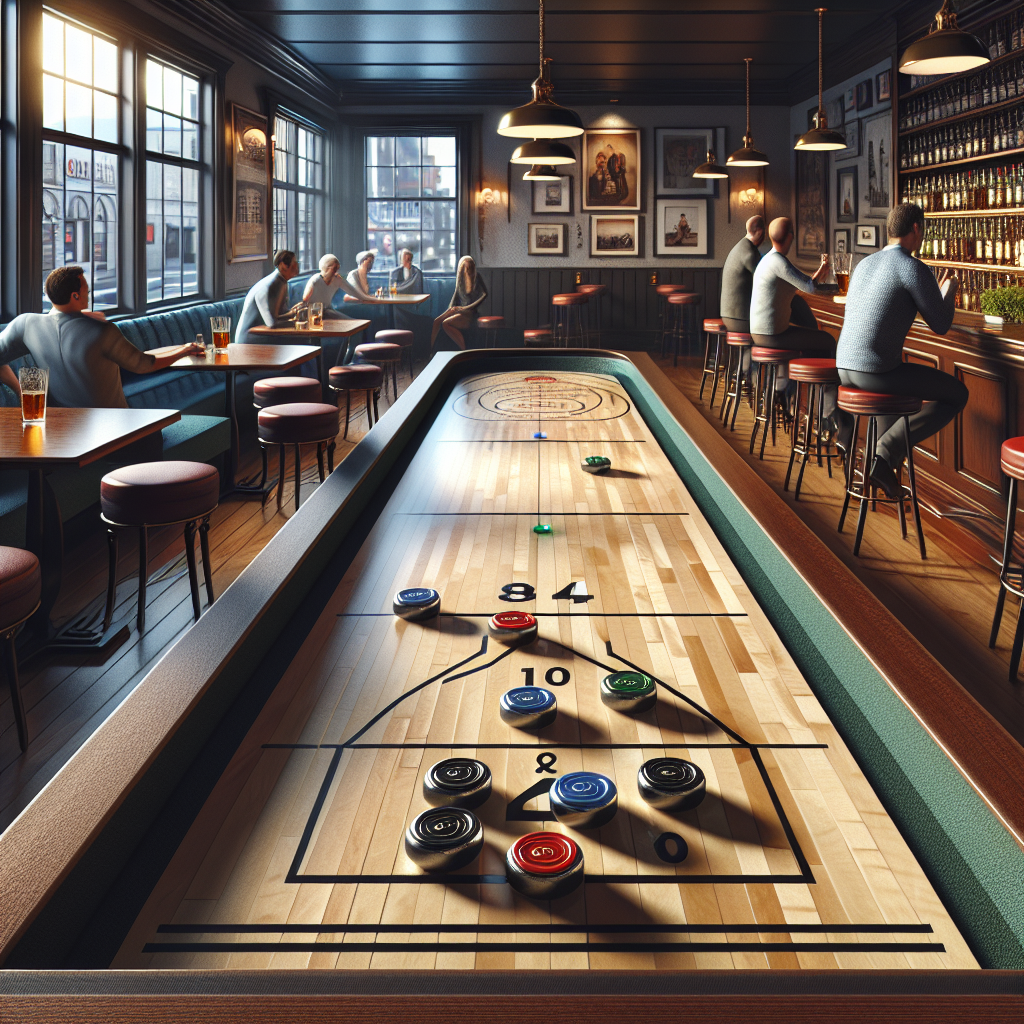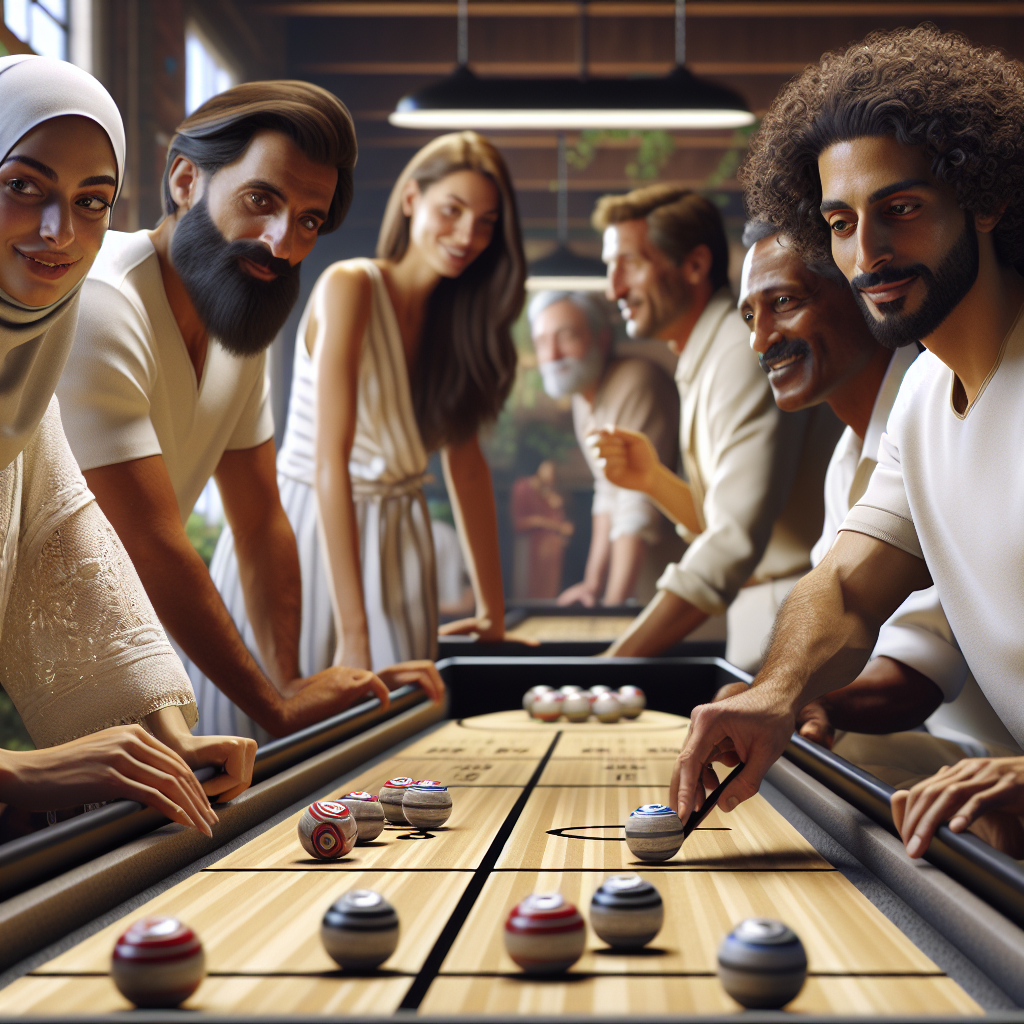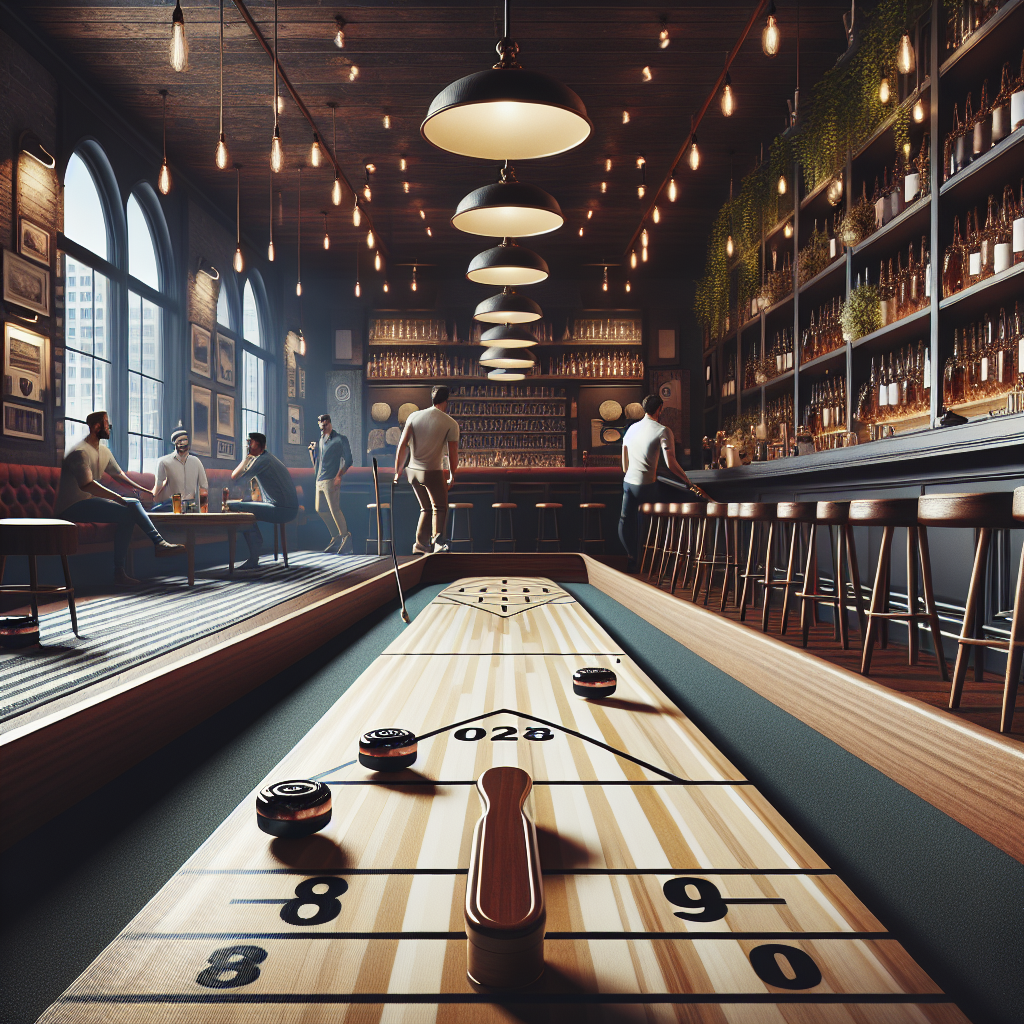Understanding Shuffleboard Basics
Before diving into advanced strategies, it’s important to have a solid understanding of the basic gameplay and scoring mechanics of bar shuffleboard.
Gameplay Overview
In bar shuffleboard, players take turns sliding all four of their weights against their opponents’ weights on a shuffleboard table. The objective is to reach the highest scoring area without falling off the end of the board into the alley (McClure Tables). Strategy comes into play as players aim to outdistance their opponents, knock off their opponents’ weights, or use their own weights to protect their highest scoring weights.
The gameplay typically follows these steps:
- Players position themselves at opposite ends of the shuffleboard table.
- Each player takes turns sliding their weights, one at a time, alternating with their opponent.
- The weights are pushed with enough force to travel down the board but with control to prevent them from sliding off the end.
- The round continues until all eight weights have been played.
- Points are then awarded based on the position and placement of the weights.
Scoring Mechanics
Scoring in shuffleboard is a straightforward process that involves assigning values to each player’s weights based on their position on the board. The scoring area is divided into three zones: the closest zone to the shuffle point is worth one point, the next furthest is worth two points, and the furthest zone is worth three points. If a weight hangs over the edge without falling off, it is worth four points.
The points are tabulated based on which player’s weights are closest to the far end of the board without going beyond the scoring area. Only the furthest weight of an individual player and any subsequent weight shuffled by the same player that surpasses the opponent’s weights count for points in a round (McClure Tables).
To determine the winner of a round, the points earned by each player are compared, and the player with the higher score receives the round’s points. The first player to reach the predetermined winning score, often 15 or 21 points, wins the game.
Understanding the basic gameplay and scoring mechanics of bar shuffleboard sets the foundation for developing effective strategies. In the next sections, we will explore the importance of observing opponents and techniques like spin and English to enhance your gameplay.
Developing Shuffleboard Strategies
To excel at bar shuffleboard and unleash your potential on the table, it’s essential to develop effective strategies. In this section, we will explore two key aspects of strategy development: the importance of observing opponents and applying spin and English techniques.
Importance of Observing Opponents
Observing your opponents’ gameplay is crucial in developing a winning strategy in shuffleboard. By paying attention to their strengths and weaknesses, you can adjust your own gameplay accordingly. For example, if you notice that an opponent tends to over-shoot, you may want to focus on longer shots that make it more challenging for them to land their discs accurately. On the other hand, if an opponent tends to under-shoot, you can consider playing shorter shots to take advantage of their weaknesses. By understanding where opponents fail and succeed, you can strategically position your own discs to gain an advantage.
Applying Spin and English Techniques
Applying spin and English techniques to your shuffleboard shots can greatly enhance your control and precision on the table. English, also known as sidespin, involves using the thumb and forefinger to apply backspin to the puck. This technique allows you to control the speed of the puck and prevent it from falling off the table. Experiment with the amount of spin applied to find the right balance for each shot. This technique is particularly useful for players who tend to use excessive power, as it helps in maintaining control and accuracy (Shuffleboard.net).
Another advanced technique to consider is side-wheeling. Side-wheeling involves shooting from the side of the table and using your third and fourth fingers to guide the puck. This technique allows for controlled shots that are risky for opponents to knock off. Side-wheeling is especially beneficial for keeping the puck close to the sides without falling off, especially on warped tables. It requires practice and precision, but it can give you a strategic advantage during gameplay.
Remember, shuffleboard strategies should be dynamic and adaptable to different tables and opponents. It’s important to practice with varying levels of power and spin to master control and precision in your gameplay. By incorporating observation of opponents’ gameplay and applying spin and English techniques, you can elevate your shuffleboard skills and increase your chances of success on the bar shuffleboard table.
For more advanced shot techniques and strategies in shuffleboard, such as the Bank Shot, Loft Shot, Precision Slide, Angle Shot, and Defensive Push, refer to our article on bar shuffleboard techniques and how to win like a pro.
Advanced Shuffleboard Techniques
As you progress in your bar shuffleboard skills, it’s essential to familiarize yourself with advanced techniques that can give you a competitive edge. In this section, we’ll explore two advanced shuffleboard techniques: the side-wheeling shot and dynamic shot adaptations.
Side-Wheeling Shot
The side-wheeling shot is a shooting technique in shuffleboard that can be highly effective, especially on longer shuffleboard tables. This technique involves shooting from the side of the table and using your third and fourth fingers to guide the puck (Shuffleboard.net). By utilizing the rail to guide your shooting hand, the side-wheeling shot allows for increased control and precision.
The advantage of the side-wheeling shot is that it enables controlled shots that are difficult for opponents to knock off. It’s particularly useful for keeping the puck close to the sides without falling off, especially on warped tables (McClure Tables). By mastering this technique, you can strategically place your pucks to obstruct your opponent’s scoring opportunities and increase your chances of scoring yourself.
Dynamic Shot Adaptations
As you become more experienced in bar shuffleboard, it’s important to be adaptable and adjust your shots based on the game situation. Dynamic shot adaptations involve modifying your shooting technique to suit different scenarios on the shuffleboard table. Some advanced shot techniques that can enhance your game include the Bank Shot, Loft Shot, Precision Slide, Angle Shot, and Defensive Push (Gaming Blaze).
The Bank Shot, for example, involves strategically bouncing pucks off the sideboards to change their trajectory and increase your scoring chances. The Loft Shot is used to clear opponents’ pucks by launching your puck high in the air and landing it precisely to knock out their pucks. The Precision Slide aims for accuracy by gliding your puck smoothly along the playing surface to reach specific scoring zones. The Angle Shot involves shooting at an angle to navigate around obstacles and position your puck advantageously. Lastly, the Defensive Push is a defensive strategy used to protect high-scoring pucks by gently nudging opponents’ pucks away from them.
By practicing and becoming proficient in these dynamic shot adaptations, you can dominate the shuffleboard table and increase your chances of winning. Remember, each shot requires precision, control, and an understanding of the game to execute effectively.
As you continue to refine your shuffleboard skills, consider incorporating these advanced techniques into your gameplay. Experiment with different shots and adapt your strategy based on the specific game situation. By doing so, you’ll elevate your bar shuffleboard abilities and unleash your full potential on the table. For more tips and strategies, check out our article on bar shuffleboard tips.
Mastering Shuffleboard Scoring
To truly excel in bar shuffleboard, it’s essential to understand the scoring system and develop effective strategies. In this section, we will explore the scoring zones breakdown and provide game-winning strategies to help you maximize your score.
Scoring Zones Breakdown
The scoring area in shuffleboard is divided into different zones, each with its own point values. The specific zones and their corresponding point values may vary slightly depending on the shuffleboard table, but the following breakdown is commonly used:
| Scoring Zones | Point Values |
|---|---|
| Closest Zone | 1 Point |
| Middle Zone | 2 Points |
| Farthest Zone | 3 Points |
| Hanging Over the Edge | 4 Points |
Points are awarded based on the location of the pucks in relation to the scoring area. The pucks that are closest to the far end without going beyond the scoring area count for points in a round. Only the furthest puck of an individual player and any subsequent puck shuffled by the same player that surpasses the opponent’s pucks count for points (McClure Tables). It’s important to carefully observe the positions of the pucks and strategize your shots accordingly.
On some shuffleboard tables, the scoring areas are divided into two main zones: the 1-2-3 zone and the 3-2-1 zone. In the 1-2-3 zone, the outermost area is worth 1 point, the middle area is worth 2 points, and the innermost area is worth 3 points. In the 3-2-1 zone, the scoring areas are reversed, with the outermost area worth 3 points, the middle area worth 2 points, and the innermost area worth 1 point (Gaming Blaze).
Game Winning Strategies
To increase your chances of winning in bar shuffleboard, it’s crucial to develop effective strategies. Here are some game-winning strategies to consider:
-
Aim for High-Scoring Areas: When shuffling your pucks, aim for the highest-scoring areas of the scoring zones. By strategically placing your pucks in these areas, you can accumulate more points and put pressure on your opponent.
-
Defensive Play: In addition to scoring points, consider using defensive play to prevent your opponent from scoring. Strategically placing your pucks to block your opponent’s scoring opportunities can give you an advantage.
-
Use Different Techniques: Familiarize yourself with different shuffleboard techniques, such as the Hammer Shot, Bumper Shot, and Precision Shot. The Hammer Shot involves forcefully knocking opponent’s pucks out, the Bumper Shot uses table walls for strategic positioning, and the Precision Shot requires careful aiming for high-scoring areas. Mastering these techniques will give you a range of options for scoring and defense.
-
Adapt to the Game: Pay attention to the positions of your opponent’s pucks and adjust your strategy accordingly. If your opponent has secured a high score in a particular area, consider focusing on other areas to surpass their score.
-
Practice and Experience: Like any skill-based game, practice and experience are key to improving your shuffleboard skills. The more you play, the better you will understand the dynamics of the game and develop your own winning strategies.
By understanding the scoring zones and implementing effective game-winning strategies, you can raise the bar in bar shuffleboard and unleash your full potential. Remember to familiarize yourself with the specific rules of the shuffleboard table you are playing on, and always maintain good sportsmanship and respect for your opponents.
Shuffleboard Etiquette
When engaging in a friendly game of bar shuffleboard, it’s important to adhere to certain rules and display good sportsmanship. Understanding and following shuffleboard etiquette ensures a smooth and enjoyable experience for all players involved.
Rules and Sportsmanship
To maintain a fair and respectful game, it’s crucial to familiarize yourself with the bar shuffleboard rules and abide by them. Here are some key aspects of shuffleboard etiquette:
-
Wait for Your Turn: Wait patiently for your turn to play and avoid interrupting other players’ shots. This allows each player to focus and perform to the best of their abilities.
-
Handle Equipment with Care: Shuffleboard discs, also known as pucks, should be handled gently to prevent damage to the playing surface. Avoid slamming or forcefully sliding the pucks, as this can cause unnecessary wear and tear on the bar shuffleboard table.
-
Keep Track of Points: It’s important to keep an accurate count of your points and be aware of the scoring mechanics. This ensures transparency and fairness throughout the game. Familiarize yourself with the bar shuffleboard scoring system to avoid any confusion.
-
Be a Good Sport: Congratulate opponents on well-played shots and show good sportsmanship, regardless of the outcome. Remember that shuffleboard is a recreational game meant to be enjoyed by all players.
Smooth Gameplay Tips
To enhance the overall shuffleboard experience, consider the following smooth gameplay tips:
-
Avoid Touching the Playing Surface: Shuffleboard rules typically prohibit players from touching the playing surface with their hands. However, players are allowed to hold onto the frame of the table with their free hand. Certain shots, such as the “cross” or “jersey shot,” may involve using the rail as a guide. Novice players often attempt the challenging “free hand” shot (Hudson Shuffleboards).
-
Maintain a Steady Pace: While it’s important to take your time to aim and strategize, maintaining a reasonable pace ensures that the game progresses smoothly. Avoid unnecessarily delaying the game by taking excessive breaks or engaging in prolonged conversations between shots.
-
Respect Other Players’ Concentration: Shuffleboard requires focus and concentration. Avoid distracting other players by keeping unnecessary noise and movement to a minimum during their turns. This allows everyone to stay focused on their shots.
By following these rules and tips, you can contribute to a positive shuffleboard experience for all players involved. Remember, shuffleboard is not only about winning but also about enjoying the game and fostering a friendly atmosphere.
Outdoor Shuffleboard Strategies
When playing outdoor shuffleboard, there are specific strategies that can help improve your game and increase your chances of scoring higher. In this section, we will explore two key strategies: penalty zone avoidance and maximizing disc placement.
Penalty Zone Avoidance
In outdoor shuffleboard, one of the most important strategies is to avoid the penalty zone at all costs. The penalty zone is an area on the shuffleboard court where discs that land receive a penalty of minus 10 points. To prevent your discs from ending up in this undesirable zone, it’s crucial to slide them with the right amount of speed and precision.
When taking your shot, aim to slide the disc with enough force to reach the scoring zones but not too much force that it travels into the penalty area. This requires practice and a good understanding of the weight and speed of your discs. By mastering the right technique, you can minimize the chances of losing points due to penalties.
Maximizing Disc Placement
Another effective strategy in outdoor shuffleboard is to maximize your disc placement to gain an advantage over your opponents. While points earned when discs land in a numbered section do not cancel out in shuffleboard, you can strategically aim your shots towards your opponents’ discs to knock them into a lower scoring zone or out of play completely. This can disrupt their game plan and increase your chances of scoring higher.
To execute this strategy, observe the positions of your opponents’ discs and plan your shots accordingly. Aim to hit their discs with enough force to alter their position on the board while still remaining within the boundaries of the scoring zones. This requires precision and careful calculation of angles and speed.
By aiming strategically at your opponents’ discs, you can not only improve your own score but also hinder their progress. However, it’s important to remember that aiming at opponents’ discs is considered a playing strategy rather than part of the scoring guidelines.
By implementing these outdoor shuffleboard strategies, you can elevate your game and increase your chances of winning. Remember to practice regularly, observe your opponents closely, and continuously refine your techniques. For more information on outdoor shuffleboard, check out our articles on bar shuffleboard rules, how to play bar shuffleboard, and bar shuffleboard tips.








